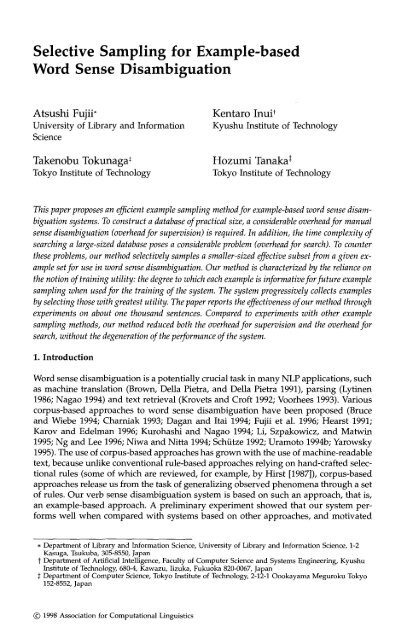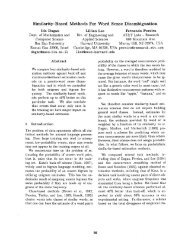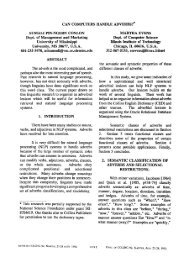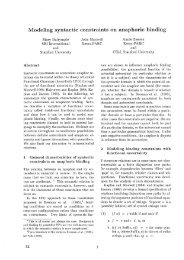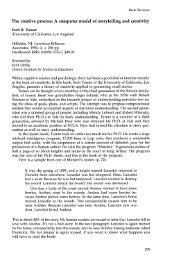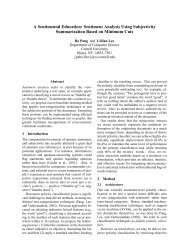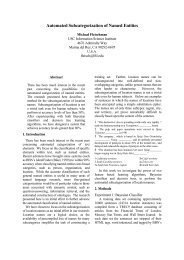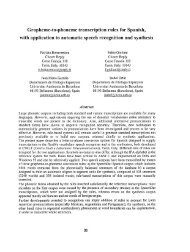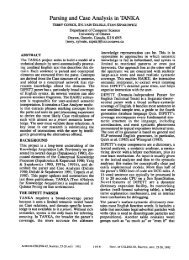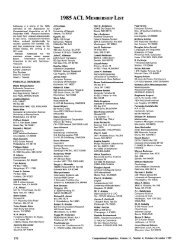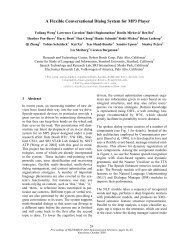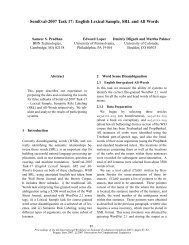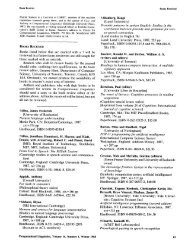Selective Sampling for Example-based Word Sense Disambiguation
Selective Sampling for Example-based Word Sense Disambiguation
Selective Sampling for Example-based Word Sense Disambiguation
You also want an ePaper? Increase the reach of your titles
YUMPU automatically turns print PDFs into web optimized ePapers that Google loves.
<strong>Selective</strong> <strong>Sampling</strong> <strong>for</strong> <strong>Example</strong>-<strong>based</strong><br />
<strong>Word</strong> <strong>Sense</strong> <strong>Disambiguation</strong><br />
Atsushi Fujii*<br />
University of Library and In<strong>for</strong>mation<br />
Science<br />
Takenobu Tokunaga *<br />
Tokyo Institute of Technology<br />
Kentaro Inui t<br />
Kyushu Institute of Technology<br />
Hozumi Tanaka ~<br />
Tokyo Institute of Technology<br />
This paper proposes an efficient example sampling method <strong>for</strong> example-<strong>based</strong> word sense disam-<br />
biguation systems. To construct a database of practical size, a considerable overhead <strong>for</strong> manual<br />
sense disambiguation (overhead <strong>for</strong> supervision) is required. In addition, the time complexity of<br />
searching a large-sized database poses a considerable problem (overhead <strong>for</strong> search). To counter<br />
these problems, our method selectively samples a smaller-sized effective subset from a given ex-<br />
ample set <strong>for</strong> use in word sense disambiguation. Our method is characterized by the reliance on<br />
the notion of training utility: the degree to which each example is in<strong>for</strong>mative <strong>for</strong> future example<br />
sampling when used <strong>for</strong> the training of the system. The system progressively collects examples<br />
by selecting those with greatest utility. The paper reports the effectiveness of our method through<br />
experiments on about one thousand sentences. Compared to experiments with other example<br />
sampling methods, our method reduced both the overhead <strong>for</strong> supervision and the overhead <strong>for</strong><br />
search, without the degeneration of the per<strong>for</strong>mance of the system.<br />
1. Introduction<br />
<strong>Word</strong> sense disambiguation is a potentially crucial task in many NLP applications, such<br />
as machine translation (Brown, Della Pietra, and Della Pietra 1991), parsing (Lytinen<br />
1986; Nagao 1994) and text retrieval (Krovets and Croft 1992; Voorhees 1993). Various<br />
corpus-<strong>based</strong> approaches to word sense disambiguation have been proposed (Bruce<br />
and Wiebe 1994; Charniak 1993; Dagan and Itai 1994; Fujii et al. 1996; Hearst 1991;<br />
Karov and Edelman 1996; Kurohashi and Nagao 1994; Li, Szpakowicz, and Matwin<br />
1995; Ng and Lee 1996; Niwa and Nitta 1994; Sch~itze 1992; Uramoto 1994b; Yarowsky<br />
1995). The use of corpus-<strong>based</strong> approaches has grown with the use of machine-readable<br />
text, because unlike conventional rule-<strong>based</strong> approaches relying on hand-crafted selec-<br />
tional rules (some of which are reviewed, <strong>for</strong> example, by Hirst [1987]), corpus-<strong>based</strong><br />
approaches release us from the task of generalizing observed phenomena through a set<br />
of rules. Our verb sense disambiguation system is <strong>based</strong> on such an approach, that is,<br />
an example-<strong>based</strong> approach. A preliminary experiment showed that our system per-<br />
<strong>for</strong>ms well when compared with systems <strong>based</strong> on other approaches, and motivated<br />
* Department of Library and In<strong>for</strong>mation Science, University of Library and In<strong>for</strong>mation Science, 1-2<br />
Kasuga, Tsukuba, 305-8550, Japan<br />
t Department of Artificial Intelligence, Faculty of Computer Science and Systems Engineering, Kyushu<br />
Institute of Technology, 680-4, Kawazu, Iizuka, Fukuoka 820-0067, Japan<br />
~t Department of Computer Science, Tokyo Institute of Technology, 2-12-10ookayama Meguroku Tokyo<br />
152-8552, Japan<br />
(~) 1998 Association <strong>for</strong> Computational Linguistics
Computational Linguistics Volume 24, Number 4<br />
us to further explore the example-<strong>based</strong> approach (we elaborate on this experiment<br />
in Section 2.3). At the same time, we concede that other approaches <strong>for</strong> word sense<br />
disambiguation are worth further exploration, and while we focus on example-<strong>based</strong><br />
approach in this paper, we do not wish to draw any premature conclusions regarding<br />
tlhe relative merits of different generalized approaches.<br />
As with most example-<strong>based</strong> systems (Fujii et al. 1996; Kurohashi and Nagao<br />
1994; Li, Szpakowicz, and Matwin 1995; Uramoto 1994b), our system uses an example<br />
database (database, hereafter) that contains example sentences associated with each<br />
verb sense. Given an input sentence containing a polysemous verb, the system chooses<br />
the most plausible verb sense from predefined candidates. In this process, the system<br />
computes a scored similarity between the input and examples in the database, and<br />
choses the verb sense associated with the example that maximizes the score. To realize<br />
this, we have to manually disambiguate polysemous verbs appearing in examples,<br />
prior to their use by the system. We shall call these examples supervised examples.<br />
A preliminary experiment on eleven polysemous Japanese verbs showed that (a) the<br />
more supervised examples we provided to the system, the better it per<strong>for</strong>med, and<br />
(b) in order to achieve a reasonable result (say over 80% accuracy), the system needed<br />
a hundred-order supervised example set <strong>for</strong> each verb. There<strong>for</strong>e, in order to build an<br />
operational system, the following problems have to be taken into account1:<br />
given human resource limitations, it is not reasonable to supervise every<br />
example in large corpora ("overhead <strong>for</strong> supervision"),<br />
given the fact that example-<strong>based</strong> systems, including our system, search<br />
the database <strong>for</strong> the examples most similar to the input, the<br />
computational cost becomes prohibitive if one works with a very large<br />
database size ("overhead <strong>for</strong> search").<br />
These problems suggest a different approach, namely to select a small number of opti-<br />
mally in<strong>for</strong>mative examples from given corpora. Hereafter we will call these examples<br />
samples.<br />
Our example sampling method, <strong>based</strong> on the utility maximization principle, de-<br />
cides on the preference <strong>for</strong> including a given example in the database. This decision<br />
procedure is usually called selective sampling (Cohn, Atlas, and Ladner 1994). The<br />
overall control flow of selective sampling systems can be depicted as in Figure 1, where<br />
"system" refers to our verb sense disambiguation system, and "examples" refers to an<br />
unsupervised example set. The sampling process basically cycles between the word<br />
sense disambiguation (WSD) and training phases. During the WSD phase, the system<br />
generates an interpretation <strong>for</strong> each polysemous verb contained in the input exam-<br />
ple ("WSD outputs" of Figure 1). This phase is equivalent to normal word sense<br />
disambiguation execution. During the training phase, the system selects samples <strong>for</strong><br />
training from the previously produced outputs. During this phase, a human expert<br />
supervises samples, that is, provides the correct interpretation <strong>for</strong> the verbs appearing<br />
in the samples. Thereafter, samples are simply incorporated into the database without<br />
any computational overhead (as would be associated with globally reestimating pa-<br />
rameters in statistics-<strong>based</strong> systems), meaning that the system can be trained on the<br />
remaining examples (the "residue") <strong>for</strong> the next iteration. Iterating between these two<br />
1 Note that these problems are associated with corpus-<strong>based</strong> approaches in general, and have been<br />
identified by a number of researchers (Engelson and Dagan 1996; Lewis and Gale 1994; Uramoto 1994a;<br />
Yarowsky 1995).<br />
574
Fujii, Inui, Tokunaga, and Tanaka <strong>Selective</strong> <strong>Sampling</strong><br />
sampling<br />
~WSD~sD out u t ~ ~ : ( ~ ~<br />
Figure 1<br />
Flow of control of the example sampling system.<br />
phases, the system progressively enhances the database. Note that the selective sam-<br />
piing procedure gives us an optimally in<strong>for</strong>mative database of a given size irrespective<br />
of the stage at which processing is terminated.<br />
Several researchers have proposed this type of approach <strong>for</strong> NLP applications.<br />
Engelson and Dagan (1996) proposed a committee-<strong>based</strong> sampling method, which<br />
is currently applied to HMM training <strong>for</strong> part-of-speech tagging. This method sets<br />
several models (the committee) taken from a given supervised data set, and selects<br />
samples <strong>based</strong> on the degree of disagreement among the committee members as to<br />
the output. This method is implemented <strong>for</strong> statistics-<strong>based</strong> models. How to <strong>for</strong>malize<br />
and map the concept of selective sampling into example-<strong>based</strong> approaches has yet to<br />
be explored.<br />
Lewis and Gale (1994) proposed an uncertainty sampling method <strong>for</strong> statistics-<br />
<strong>based</strong> text classification. In this method, the system always samples outputs with an<br />
uncertain level of correctness. In an example-<strong>based</strong> approach, we should also take<br />
into account the training effect a given example has on other unsupervised examples.<br />
This is introduced as training utility in our method. We devote Section 4 to further<br />
comparison of our approach and other related works.<br />
With respect to the problem of overhead <strong>for</strong> search, possible solutions would in-<br />
clude the generalization of similar examples (Kaji, Kida, and Morimoto 1992; Nomi-<br />
yama 1993) or the reconstruction of the database using a small portion of useful in-<br />
stances selected from a given supervised example set (Aha, Kibler, and Albert 1991;<br />
Smyth and Keane 1995). However, such approaches imply a significant overhead <strong>for</strong><br />
supervision of each example prior to the system's execution. This shortcoming is pre-<br />
cisely what our approach aims to avoid: we aim to reduce the overhead <strong>for</strong> supervision<br />
as well as the overhead <strong>for</strong> search.<br />
Section 2 describes the basis of our verb sense disambiguation system and pre-<br />
liminary experiment, in which we compared our method with other disambiguation<br />
methods. Section 3 then elaborates on our example sampling method. Section 4 reports<br />
on the results of our experiments through comparison with other proposed selective<br />
sampling methods, and discusses theoretical differences between those methods.<br />
2. <strong>Example</strong>-<strong>based</strong> Verb <strong>Sense</strong> <strong>Disambiguation</strong> System<br />
2.1 The Basic Idea<br />
Our verb sense disambiguation system is <strong>based</strong> on the method proposed by Kurohashi<br />
and Nagao (1994) and later enhanced by Fujii et al. (1996). The system uses a database<br />
containing examples of collocations <strong>for</strong> each verb sense and its associated case frame(s).<br />
575
Computational Linguistics Volume 24, Number 4<br />
kanojo (she) ga<br />
I kane (money) }<br />
otoko (man) wo toru (to take/steal)<br />
{suri(pickpocket)} sa0eu (wallet)<br />
ani (brother) urea (horse)<br />
aidea (idea)<br />
I kare (he) menkyoshou (license)<br />
kanojo(she)}ga {shikaku (qualification)}wotoru(toattain)<br />
gakusei (student) biza (visa)<br />
kare (he) }<br />
chichi<br />
{shinbun(newspaper)}<br />
(father) ga zasshi (journal) wo toru (to subscribe)<br />
kyaku (client)<br />
{kare (he) {kippu(ticket)}<br />
dantai (group) ga heya (room) wo toru (to reserve)<br />
ryokoukyaku (passenger)<br />
joshu (assistant) hikouki (airplane)<br />
Figure 2<br />
A fragment of the database, and the entry associated with the Japanese verb toru.<br />
Figure 2 shows a fragment of the entry associated with the Japanese verb toru. The<br />
verb toru has multiple senses, a sample of which are 'to take/steal,' 'to attain,' 'to<br />
subscribe,' and 'to reserve.' The database specifies the case frame(s) associated with<br />
each verb sense. In Japanese, a complement of a verb consists of a noun phrase (case<br />
filler) and its case marker suffix, <strong>for</strong> example ga (nominative) or wo (accusative). The<br />
database lists several case filler examples <strong>for</strong> each case. The task of the system is to<br />
"interpret" the verbs occurring in the input text, i.e., to choose one sense from among a<br />
set of candidates. 2 All verb senses we use are defined in IPAL (in<strong>for</strong>mation-technology<br />
Promotion Agency, 1987), a machine-readable dictionary. IPAL also contains example<br />
case fillers as shown in Figure 2. Given an input, which is currently limited to a simple<br />
sentence, the system identifies the verb sense on the basis of the scored similarity<br />
between the input and the examples given <strong>for</strong> each verb sense. Let us take the sentence<br />
below as an example input:<br />
hisho ga shindaisha wo toru.<br />
(secretary-NOM) (sleeping car-ACC) (?)<br />
In this example, one may consider hisho ('secretary') and shindaisha ('sleeping car')<br />
to be semantically similar to joshu ('assistant') and hikouki ('airplane') respectively, and<br />
since both collocate with the 'to reserve' sense of toru, one could infer that toru should<br />
be interpreted as 'to reserve.' This resolution originates from the analogy principle<br />
(Nagao 1984), and can be called nearest neighbor resolution because the verb in the<br />
input is disambiguated by superimposing the sense of the verb appearing in the exam-<br />
ple of highest similarity. 3 The similarity between an input and an example is estimated<br />
<strong>based</strong> on the similarity between case lers marked with the same case.<br />
Furthermore, since the restrictions imposed by the case fillers in choosing the verb<br />
sense are not equally selective, Fujii et al. (1996) proposed a weighted case contribution<br />
to disambiguation (CCD) of the verb senses. This CCD factor is taken into account<br />
2 Note that unlike the automatic acquisition of word sense definitions (Fukumoto and Tsujii 1994;<br />
Pustejovsky and Boguraev 1993; Utsuro 1996; Zernik 1989), the task of the system is to identify the best<br />
matched category with a given input, from predefined candidates.<br />
3 In this paper, we use "example-<strong>based</strong> systems" to refer to systems <strong>based</strong> on nearest neighbor resolution.<br />
576
Fujii, Inui, Tokunaga, and Tanaka <strong>Selective</strong> <strong>Sampling</strong><br />
©<br />
nominative accusative<br />
Figure 3<br />
The semantic ranges of the nominative and accusative <strong>for</strong> the verb toru.<br />
database<br />
nq-mc~nc nc3-rnllc3 v (?)<br />
Cs~,c~ G,c2 &,;3 -- v<br />
Figure 4<br />
An input and the database.<br />
(s~)l<br />
-- ~s3,c2 ~s3,C3 - -- V (S3) J<br />
when computing the score <strong>for</strong> each sense of the verb in question. Consider again the<br />
case of toru in Figure 2. Since the semantic range of nouns collocating with the verb<br />
in the nominative does not seem to have a strong delinearization in a semantic sense<br />
(in Figure 2, the nominative of each verb sense displays the same general concept, i.e.,<br />
HUMAN), it would be difficult, or even risky, to properly interpret the verb sense <strong>based</strong><br />
on similarity in the nominative. In contrast, since the semantic ranges are disparate in<br />
tile accusative, it would be feasible to rely more strongly on similarity here.<br />
This argument can be illustrated as in Figure 3, in which the symbols el and e2<br />
denote example case fillers of different case frames, and an input sentence includes two<br />
case fillers denoted by x and y. The figure shows the distribution of example case fillers<br />
<strong>for</strong> the respective case frames, denoted in a semantic space. The semantic similarity<br />
between two given case fillers is represented by the physical distance between the<br />
two symbols. In the nominative, since x happens to be much closer to an e2 than any<br />
el, x may be estimated to belong to the range of e2's, although x actually belongs to<br />
both sets of el's and e2's. In the accusative, however, y would be properly estimated<br />
to belong to the set of el's due to the disjunction of the two accusative case filler sets,<br />
even though examples do not fully cover each of the ranges of el's and e2's. Note<br />
that this difference would be critical if example data were sparse. We will explain the<br />
method used to compute CCD in Section 2.2.<br />
2.2 Methodology<br />
To illustrate the overall algorithm, we will consider an abstract specification of both<br />
an input and the database (Figure 4). Let the input be {no1 - reel, nc2 - mc2, nc3 - rnc3, v},<br />
where nci denotes the case filler <strong>for</strong> the case ci, and mci denotes the case marker <strong>for</strong> ci,<br />
and assume that the interpretation candidates <strong>for</strong> v are derived from the database as<br />
sl, s2 and s3. The database also contains a set Gi,cj of case filler examples <strong>for</strong> each case<br />
cj of each sense si ("--" indicates that the corresponding case is not allowed).<br />
During the verb sense disambiguation process, the system first discards those<br />
candidates whose case frame does not fit the input. In the case of Figure 4, s3 is<br />
discarded because the case frame of v (s3) does not subcategorize <strong>for</strong> the case cl.<br />
577
Computational Linguistics Volume 24, Number 4<br />
Table 1<br />
The relation between the length of the path<br />
between two nouns nl and n2 in the<br />
Bunruigoihyo thesaurus (len(nl, n2)), and<br />
their relative similarity (sire(n1, n2)).<br />
fen(n1, n2) 0 2 4 6 8 10 12<br />
sire(n1, n2) 11 10 9 8 7 5 0<br />
In the next step the system computes the score of the remaining candidates and<br />
chooses as the most plausible interpretation the one with the highest score. The score<br />
of an interpretation is computed by considering the weighted average of the similarity<br />
degrees of the input case fillers with respect to each of the example case lers (in the<br />
corresponding case) listed in the database <strong>for</strong> the sense under evaluation. Formally,<br />
this is expressed by Equation (1), where Score(s) is the score of sense s of the input<br />
verb, and SIM(nc, G,c) is the maximum similarity degree between the input case filler nc<br />
and the corresponding case fillers in the database example set ~s,c (calculated through<br />
Equation (2)). CCD(c) is the weight factor of case c, which we will explain later in this<br />
section.<br />
Score(s) = ~c SIM(n¢, &,c)' CCD(c) (1)<br />
CCD(c)<br />
SIM(nc, &,c) = max sim(nc, e) (2)<br />
eC G,c<br />
With regard to the computation of the similarity between two different case fillers<br />
(sim(n~, e) in Equation (1)), we experimentally used two alternative approaches. The<br />
first approach uses semantic resources, that is, hand-crafted thesauri (such as the Ro-<br />
ger's thesaurus [Chapman 1984] or <strong>Word</strong>Net [Miller et al. 1993] in the case of English,<br />
and Bunruigoihyo [National Language Research Institute 1964] or EDR [Japan Electronic<br />
Dictionary Research Institute 1995] in the case of Japanese), <strong>based</strong> on the intuitively<br />
feasible assumption that words located near each other within the structure of a the-<br />
saurus have similar meaning. There<strong>for</strong>e, the similarity between two given words is<br />
:represented by the length of the path between them in the thesaurus structure (Fujii<br />
et al. 1996; Kurohashi and Nagao 1994; Li, Szpakowicz, and Matwin 1995; Uramoto<br />
1994b). 4 We used the similarity function empirically identified by Kurohashi and Na-<br />
gao in which the relation between the length of the path in the Bunruigoihyo thesaurus<br />
and the similarity between words is defined as shown in Table 1. In this thesaurus,<br />
each entry is assigned a seven-digit class code. In other words, this thesaurus can be<br />
considered as a tree, seven levels in depth, with each leaf as a set of words. Figure 5<br />
shows a fragment of the Bunruigoihyo thesaurus including some of the nouns in both<br />
Figure 2 and the input sentence above.<br />
The second approach is <strong>based</strong> on statistical modeling. We adopted one typical<br />
implementation called the "vector space model" (VSM) (Frakes and Baeza-Yates 1992;<br />
Leacock, Towell, and Voorhees 1993; Salton and McGill 1983; Sch/itze 1992), which has<br />
a long history of application in in<strong>for</strong>mation retrieval (IR) and text categorization (TC)<br />
tasks. In the case of IR/TC, VSM is used to compute the similarity between documents,<br />
which is represented by a vector comprising statistical factors of content words in a<br />
document. Similarly, in our case, each noun is represented by a vector comprising<br />
4 Different types of application of hand-crafted thesauri to word sense disambiguation have been<br />
proposed, <strong>for</strong> example, by Yarowsky (1992).<br />
578
Fujii, Inui, Tokunaga, and Tanaka <strong>Selective</strong> <strong>Sampling</strong><br />
I I<br />
kare kanojo<br />
(he) (she)<br />
Figure 5<br />
A fragment of the Bunruigoihyo thesaurus.<br />
I IIII<br />
otoko joshu hisho kane heya kippu uma<br />
(man) (assistant) (secretary)(money) (room) (ticket) (horse)<br />
statistical factors, although statistical factors are calculated in terms of the predicate<br />
argument structure in which each noun appears. Predicate argument structures, which<br />
consist of complements (case filler nouns and case markers) and verbs, have also<br />
been used in the task of noun classification (Hindle 1990). This can be expressed by<br />
Equation (3), where ff is the vector <strong>for</strong> the noun in question, and items ti represent the<br />
statistics <strong>for</strong> predicate argument structures including n.<br />
ff = (h, t2,..., ti .... ) (3)<br />
In regard to ti, we used the notion of TF. IDF (Salton and McGill 1983). TF (term<br />
frequency) gives each context (a case marker/verb pair) importance proportional to<br />
the number of times it occurs with a given noun. The rationale behind IDF (inverse<br />
document frequency) is that contexts that rarely occur over collections of nouns are<br />
valuable, and that there<strong>for</strong>e the IDF of a context is inversely proportional to the number<br />
of noun types that appear in that context. This notion is expressed by Equation (4),<br />
wheref((n, c, v)) is the frequency of the tuple (n, c, v), nf((c, v)) is the number of noun<br />
types which collocate with verb v in the case c, and N is the number of noun types<br />
within the overall co-occurrence data.<br />
N<br />
ti =d((n, c, v)). log nf((c, v)) (4)<br />
We compute the similarity between nouns nt and n2 by the cosine of the angle between<br />
the two vectors t~ and n2. This is realized by Equation (5).<br />
/I/1 " n2<br />
sire(n1, n2) - ~ ]]~21 (5)<br />
We extracted co-occurrence data from the RWC text base RWC-DB-TEXT-95-1 (Real<br />
World Computing Partnership 1995). This text base consists of four years worth of<br />
Mainichi Shimbun newspaper articles (Mainichi Shimbun 1991-1994), which have been<br />
automatically annotated with morphological tags. The total morpheme content is about<br />
one hundred million. Since full parsing is usually expensive, a simple heuristic rule<br />
was used to obtain collocations of nouns, case markers, and verbs in the <strong>for</strong>m of tuples<br />
(n, c, v). This rule systematically associates each sequence of noun and case marker to<br />
the verb of highest proximity, and produced 419,132 tuples. This co-occurrence data<br />
was used in the preliminary experiment described in Section 2.3. s<br />
5 Note that each verb in co-occurrence data should ideally be annotated with its verb sense. However,<br />
there is no existing Japanese text base with sufficient volume of word sense tags.<br />
579
Computational Linguistics Volume 24, Number 4<br />
In Equation (1), CCD(c) expresses the weight factor of the contribution of case c to<br />
(current) verb sense disambiguation. Intuitively, preference should be given to cases<br />
displaying case fillers that are classified in semantic categories of greater disjunction.<br />
Thus, c's contribution to the sense disambiguation of a given verb, CCD(c), is likely<br />
to be higher if the example case filler sets {gsi,c I i = 1,..., n} share fewer elements, as<br />
in Equation (6).<br />
C' 1 r~-I __ ~<br />
CCD(c) = ~,7~ ~ ~ Igs''¢l + ]£s,,cl 2[£s~,c r"l £s,,~l<br />
j=i+l I&,,I 7 I'G*I )<br />
Here, o~ is a constant <strong>for</strong> pararneterizing the extent to which CCD influences verb<br />
sense disambiguation. The larger oe is, the stronger is CCD's influence on the system<br />
output. To avoid data sparseness, we smooth each element (noun example) in gsi,c. In<br />
practice, this involves generalizing each example noun into a five-digit class <strong>based</strong> on<br />
the Bunruigoihyo thesaurus, as has been commonly used <strong>for</strong> smoothing.<br />
2.3 Preliminary Experimentation<br />
We estimated the per<strong>for</strong>mance of our verb sense disambiguation method through an<br />
experiment, in which we compared the following five methods:<br />
• lower bound (LB), in which the system systematically chooses the most<br />
frequently appearing verb sense in the database (Gale, Church, and<br />
Yarowsky 1992),<br />
• rule-<strong>based</strong> method (RB), in which the system uses a thesaurus to<br />
(automatically) identify appropriate semantic classes as selectional<br />
restrictions <strong>for</strong> each verb complement,<br />
• Naive-Bayes method (NB), in which the system interprets a given verb<br />
<strong>based</strong> on the probability that it takes each verb sense,<br />
• example-<strong>based</strong> method using the vector space model (VSM), in which<br />
the system uses the above mentioned co-occurrence data extracted from<br />
the RWC text base,<br />
• example-<strong>based</strong> method using the Bunruigoihyo thesaurus (BGH), in<br />
which the system uses Table 1 <strong>for</strong> the similarity computation.<br />
In the rule-<strong>based</strong> method, selectional restrictions are represented by thesaurus<br />
classes, and allow only those nouns dominated by the given class in the thesaurus<br />
structure as verb complements. In order to identify appropriate thesaurus classes,<br />
we used the association measure proposed by Resnik (1993), which computes the<br />
in<strong>for</strong>mation-theoretic association degree between case fillers and thesaurus classes,<br />
<strong>for</strong> each verb sense (Equation (7)). 6<br />
P(rls, c)<br />
A(s,c,r) = P(rls, c ) • log p(rlc) (7)<br />
6 Note that previous research has applied this technique to tasks other than verb sense disambiguation,<br />
such as syntactic disambiguation (Resnik 1993) and disambiguation of case filler noun senses (Ribas<br />
1995).<br />
580<br />
(6)
Fujii, Inui, Tokunaga, and Tanaka <strong>Selective</strong> <strong>Sampling</strong><br />
Here, A(s, c, r) is the association degree between verb sense s and class r (selectional<br />
restriction candidate) with respect to case c. P(rls, c) is the conditional probability that<br />
a case filler example associated with case c of sense s is dominated by class r in the<br />
thesaurus. P(rlc ) is the conditional probability that a case filler example <strong>for</strong> case c<br />
(disregarding verb sense) is dominated by class r. Each probability is estimated <strong>based</strong><br />
on training data. We used the semantic classes defined in the Bunruigoihyo thesaurus.<br />
In practice, every r whose association degree is above a certain threshold is chosen<br />
as a selectional restriction (Resnik 1993; Ribas 1995). By decreasing the value of the<br />
threshold, system coverage can be broadened, but this opens the way <strong>for</strong> irrelevant<br />
(noisy) selectional rules.<br />
The Naive-Bayes method assumes that each case filler included in a given input is<br />
conditionally independent of other case fillers: the system approximates the probability<br />
that an input x takes a verb sense s (P(slx)), simply by computing the product of the<br />
probability that each verb sense s takes nc as a case filler <strong>for</strong> case c. The verb sense<br />
with maximal probability is then selected as the interpretation (Equation (8)). 7<br />
arg msax P(slx)<br />
P(s) . P(xls)<br />
= arg msax P(x)<br />
= argn~axP(s). P(xls)<br />
argmaxP(s) II P(ncls)<br />
Here, P(ncls) is the probability that a case filler associated with sense s <strong>for</strong> case c in the<br />
training data is nc. We estimated P(s) <strong>based</strong> on the distribution of the verb senses in the<br />
training data. In practice, data sparseness leads to not all case fillers nc appearing in<br />
the database, so we generalize each nc into a semantic class defined in the Bunruigoihyo<br />
thesaurus.<br />
All methods except the lower bound method involve a parametric constant: the<br />
threshold value <strong>for</strong> the association degree (RB), a generalization level <strong>for</strong> case filler<br />
nouns (NB), and a in Equation (6) (VSM and BGH). For these parameters, we con-<br />
ducted several trials prior to the actual comparative experiment, to determine the<br />
optimal parameter values over a range of data sets. For our method, we set a ex-<br />
tremely large, which is equivalent to relying almost solely on the SIM of the case with<br />
the greatest CCD. However, note that when the SIM of the case with the greatest CCD<br />
is equal <strong>for</strong> multiple verb senses, the system computes the SIM of the case with the<br />
second highest CCD. This process is repeated until only one verb sense remains. When<br />
more than one verb sense is selected <strong>for</strong> any given method (or none of them remains,<br />
<strong>for</strong> the rule-<strong>based</strong> method), the system simply selects the verb sense that appears most<br />
frequently in the database, s<br />
In the experiment, we conducted sixfold cross-validation, that is, we divided the<br />
training/test data into six equal parts, and conducted six trials in which a different<br />
7 A number of experimental results have shown the effectiveness of the Naive-Bayes method <strong>for</strong> word<br />
sense disambiguation (Gale, Church, and Yarowsky 1993; Leacock, Towell, and Voorhees 1993; Mooney<br />
1996; Ng 1997; Pedersen, Bruce, and Wiebe 1997).<br />
8 One may argue that this goes against the basis of the rule-<strong>based</strong> method, in that, given a proper<br />
threshold value <strong>for</strong> the association degree, the system could improve on accuracy (potentially<br />
sacrificing coverage), and that the trade-off between coverage and accuracy is there<strong>for</strong>e a more<br />
appropriate evaluation criterion. However, our trials on the rule-<strong>based</strong> method with different threshold<br />
values did not show significant correlation between the improvement of accuracy and the degeneration<br />
of coverage.<br />
c<br />
(8)<br />
581
Computational Linguistics Volume 24, Number 4<br />
Table 2<br />
The verbs contained in the corpus used, and the accuracy of the different verb sense<br />
disambiguation methods (LB: lower bound, RB: rule-<strong>based</strong> method, NB: Naive-Bayes<br />
method, VSM: vector space model, BGH: the Bunruigoihyo thesaurus).<br />
Verb<br />
# of # of Accuracy (%)<br />
English Gloss Sentences <strong>Sense</strong>s LB RB NB VSM BGH<br />
ataeru give 136 4 66.9 62.1 75.8 84.1 86.0<br />
kakeru hang 160 29 25.6 24.6 67.6 73.4 76.2<br />
kuwaeru add 167 5 53.9 65.6 82.2 84.0 86.8<br />
motomeru require 204 4 85.3 82.4 87.0 85.5 85.5<br />
noru ride 126 10 45.2 52.8 81.4 80.5 85.3<br />
osameru govern 108 8 30.6 45.6 66.0 72.0 74.5<br />
tsukuru make 126 15 25.4 24.9 59.1 56.5 69.9<br />
toru take 84 29 26.2 16.2 56.1 71.2 75.9<br />
umu bear offspring 90 2 83.3 94.7 95.5 92.0 99.4<br />
wakaru understand 60 5 48.3 40.6 71.4 62.5 70.7<br />
yameru stop 54 2 59.3 89.9 92.3 96.2 96.3<br />
total -- 1,315 -- 51.4 54.8 76.6 78.6 82.3<br />
part was used as test data each time, and the rest as training data (the database). 9 We<br />
evaluated the per<strong>for</strong>mance of each method according to its accuracy, that is, the ratio<br />
of the number of correct outputs compared to the total number of inputs. The train-<br />
ing/test data used in the experiment contained about one thousand simple Japanese<br />
sentences collected from news articles. Each sentence in the training/test data con-<br />
tained one or more complement(s) followed by one of the eleven verbs described in<br />
Table 2. In Table 2, the column "English Gloss" describes typical English translations<br />
of the Japanese verbs. The column "# of Sentences" denotes the number of sentences<br />
in the corpus, and "# of <strong>Sense</strong>s" denotes the number of verb senses contained in IPAL.<br />
The column "accuracy" shows the accuracy of each method.<br />
Looking at Table 2, one can see that our example-<strong>based</strong> method per<strong>for</strong>med bet-<br />
ter than the other methods (irrespective of the similarity computation), although the<br />
Naive-Bayes method is relatively comparable in per<strong>for</strong>mance. Surprisingly, despite the<br />
relatively ad hoc similarity definition used (see Table 1), the Bunruigoihyo thesaurus<br />
led to a greater accuracy gain than the vector space model. In order to estimate the<br />
upper bound (limitation) of the disambiguation task, that is, to what extent a human<br />
expert makes errors in disambiguation (Gale, Church, and Yarowsky 1992), we ana-<br />
lyzed incorrect outputs and found that roughly 30% of the system errors using the<br />
Bunruigoihyo thesaurus fell into this category. It should be noted that while the vector<br />
space model requires computational cost (time/memory) of an order proportional to<br />
the size of the vector, determination of paths in the Bunruigoihyo thesaurus comprises<br />
a trivial cost.<br />
We also investigated errors made by the rule-<strong>based</strong> method to find a rational ex-<br />
planation <strong>for</strong> its inferiority. We found that the association measure in Equation (7)<br />
tends to give a greater value to less frequently appearing verb senses and lower level<br />
9 Ideally speaking, training and test data should be drawn from different sources, to simulate a real<br />
application. However, the sentences were already scrambled when provided to us, and there<strong>for</strong>e we<br />
could not identify the original source corresponding to each sentence.<br />
582
Fujii, Inui, Tokunaga, and Tanaka <strong>Selective</strong> <strong>Sampling</strong><br />
(more specified) classes, and there<strong>for</strong>e chosen rules are generally overspecified. 1° Con-<br />
sequently, frequently appearing verb senses are likely to be rejected. On the other<br />
hand, when attempting to enhance the rule set by setting a smaller threshold value<br />
<strong>for</strong> the association score, overgeneralization can be a problem. We also note that one<br />
of the theoretical differences between the rule-<strong>based</strong> and example-<strong>based</strong> methods is<br />
that the <strong>for</strong>mer statically generalizes examples (prior to system usage), while the lat-<br />
ter does so dynamically. Static generalization would appear to be relatively risky <strong>for</strong><br />
sparse training data.<br />
Although comparison of different approaches to word sense disambiguation should<br />
be further investigated, this experimental result gives us good motivation to explore<br />
example-<strong>based</strong> verb sense disambiguation approaches, i.e., to introduce the notion of<br />
selective sampling into them.<br />
2.4 Enhancement of Verb <strong>Sense</strong> <strong>Disambiguation</strong><br />
Let us discuss how further enhancements to our example-<strong>based</strong> verb sense disam-<br />
biguation system could be made. First, since inputs are simple sentences, in<strong>for</strong>mation<br />
<strong>for</strong> word sense disambiguation is inadequate in some cases. External in<strong>for</strong>mation such<br />
as the discourse or domain dependency of each word sense (Guthrie et al. 1991; Na-<br />
sukawa 1993; Yarowsky 1995) is expected to lead to system improvement. Second,<br />
some idiomatic expressions represent highly restricted collocations, and overgener-<br />
alizing them semantically through the use of a thesaurus can cause further errors.<br />
Possible solutions would include one proposed by Uramoto, in which idiomatic ex-<br />
pressions are described separately in the database so that the system can control their<br />
overgeneralization (Uramoto 1994b). Third, a number of existing NLP tools such as<br />
JUMAN (a morphological analyzer) (Matsumoto et al. 1993) and QJP (a morphological<br />
and syntactic analyzer) (Kameda 1996) could broaden the coverage of our system, as<br />
inputs are currently limited to simple, morphologically analyzed sentences. Finally, it<br />
should be noted that in Japanese, case markers can be omitted or topicalized (<strong>for</strong> exam-<br />
ple, marked with postposition wa), an issue which our framework does not currently<br />
consider.<br />
3. <strong>Example</strong> <strong>Sampling</strong> Algorithm<br />
3.1 Overview<br />
Let us look again at Figure 1 in Section 1. In this figure, "WSD outputs" refers to a<br />
corpus in which each sentence is assigned an expected verb interpretation during the<br />
WSD phase. In the training phase, the system stores supervised samples (with each<br />
interpretation simply checked or appropriately corrected by a human) in the database,<br />
to be used in a later WSD phase. In this section, we turn to the problem of which<br />
examples should be selected as samples.<br />
Lewis and Gale (1994) proposed the notion of uncertainty sampling <strong>for</strong> the training<br />
of statistics-<strong>based</strong> text classifiers. Their method selects those examples that the system<br />
classifies with minimum certainty, <strong>based</strong> on the assumption that there is no need <strong>for</strong><br />
teaching the system the correct answer when it has answered with sufficiently high<br />
certainty. However, we should take into account the training effect a given example has<br />
on other remaining (unsupervised) examples. In other words, we would like to select<br />
samples so as to be able to correctly disambiguate as many examples as possible in the<br />
next iteration. If this is successfully done, the number of examples to be supervised will<br />
10 This problem has also been identified by Charniak (1993).<br />
583
Computational Linguistics Volume 24, Number 4<br />
el: seito ga (student-NOM) shitsumon wo (question-ACC) yameru (sl)<br />
e2: ani ga (brother-NOM) kaisha wo (company-ACC) yameru (s2)<br />
Xl: shain ga (employee-NOM) eigyou wo (sales-ACC) yameru (?)<br />
x2: shouten ga (store-NOM) eigyou wo (sales-ACC) yameru (?)<br />
x3: koujou ga (factory-NOM) sougyou wo (operation-ACC) yameru (?)<br />
x4: shisetsu ga (facility-NOM) unten wo (operation-ACC) yameru (?)<br />
xs: senshu ga (athlete-NOM) renshuu wo (pracfice-ACC) yameru (?)<br />
x6: musuko ga (son-NOM) kaisha wo (company-ACC) yameru (?)<br />
x7: kangofu ga (nurse-NOM) byouin wo (hospital-ACC) yameru (?)<br />
x8: hikoku ga (defendant-NOM) giin wo (congressman-ACC) yameru (?)<br />
xg: chichi ga (father-NOM) kyoushi wo (teacher-ACC) yameru (?)<br />
Figure 6<br />
<strong>Example</strong> of a given corpus associated with the verb yameru.<br />
decrease. We consider maximization of this effect by means of a training utility function<br />
aimed at ensuring that the most useful example at a given point in time is the example<br />
with the greatest training utility factor. Intuitively speaking, the training utility of an<br />
example is greater when we can expect greater increase in the interpretation certainty<br />
of the remaining examples after training using that example.<br />
To explain this notion intuitively, let us take Figure 6 as an example corpus. In<br />
this corpus, all sentences contain the verb yameru, which has two senses according<br />
to IPAL, sl ('to stop (something)') and s2 ('to quit (occupation)'). In this figure, sen-<br />
tences el and e2 are supervised examples associated with senses Sl and s2, respectively,<br />
and xi's are unsupervised examples. For the sake of enhanced readability, the exam-<br />
ples xi's are partitioned according to their verb senses, that is, xl to x5 correspond<br />
to sense Sl, and x6 to x9 correspond to sense s2. In addition, note that examples in<br />
the corpus can be readily categorized <strong>based</strong> on case similarity, that is, into clusters<br />
{Xl, X2, X3, X4} ('someone/something stops service'), {Ca, X6, X7} ('someone leaves orga-<br />
nization'), {Xs, X9} ('someone quits occupation'), {el}, and {Xs}. Let us simulate the<br />
sampling procedure with this example corpus. In the initial stage with {el, e2} in the<br />
database, x6 and x7 can be interpreted as s2 with greater certainty than <strong>for</strong> the other<br />
xi's, because these two examples are similar to e2. There<strong>for</strong>e, uncertainty sampling<br />
selects any example except x6 and x7 as the sample. However, any one of examples Xl<br />
to x4 is more desirable because by way of incorporating one of these examples, we can<br />
obtain more xi's with greater certainty. Assuming that Xl is selected as the sample and<br />
incorporated into the database with sense Sl, either of x8 and x9 will be more highly<br />
desirable than other unsupervised xi's in the next stage.<br />
Let S be a set of sentences, i.e., a given corpus, and D be the subset of supervised<br />
examples stored in the database. Further, let X be the set of unsupervised examples,<br />
realizing Equation (9).<br />
S = D u X (9)<br />
The example sampling procedure can be illustrated as:<br />
1. WSD(D, X)<br />
2. e ~ arg maxx~x TU(x)<br />
3. D ~--D U {e}, X ~-- X n {e}<br />
4. goto 1<br />
where WSD(D, X) is the verb sense disambiguation process on input X using D as<br />
the database. In this disambiguation process, the system outputs the following <strong>for</strong><br />
584
Fujii, Inui, Tokunaga, and Tanaka <strong>Selective</strong> <strong>Sampling</strong><br />
X X<br />
sense I<br />
(x e xl x fsense2<br />
(:ex)<br />
x ,,..._y<br />
X<br />
X<br />
sense I<br />
Ix d sense 2<br />
e t 'x) x )<br />
(a) (b)<br />
Figure 7<br />
The concept of interpretation certainty. The case where the interpretation certainty of the<br />
enclosed x's is great is shown in (a). The case where the interpretation certainty of the x's<br />
contained in the intersection of senses 1 and 2 is small is shown in (b).<br />
each input: (a) a set of verb sense candidates with interpretation scores, and (b) an<br />
interpretation certainty. These factors are used <strong>for</strong> the computation of TU(x), newly<br />
introduced in our method. TU(x) computes the training utility factor <strong>for</strong> an example<br />
x. The sampling algorithm gives preference to examples of maximum utility.<br />
We will explain in the following sections how TU(x) is estimated, <strong>based</strong> on the<br />
estimation of the interpretation certainty.<br />
3.2 Interpretation Certainty<br />
Lewis and Gale (1994) estimate certainty of an interpretation as the ratio between the<br />
probability of the most plausible text category and the probability of any other text<br />
category, excluding the most probable one. Similarly, in our verb sense disambiguation<br />
system, we introduce the notion of interpretation certainty of examples <strong>based</strong> on the<br />
following preference conditions:<br />
.<br />
2.<br />
the highest interpretation score is greater,<br />
the difference between the highest and second highest interpretation<br />
scores is greater.<br />
The rationale <strong>for</strong> these conditions is given below. Consider Figure 7, where each sym-<br />
bol denotes an example in a given corpus, with symbols x as unsupervised examples<br />
and symbols e as supervised examples. The curved lines delimit the semantic vicini-<br />
ties (extents) of the two verb senses 1 and 2, respectively. 11 The semantic similarity<br />
between two examples is graphically portrayed by the physical distance between the<br />
two symbols representing them. In Figure 7(a), x's located inside a semantic vicinity<br />
are expected to be interpreted as being similar to the appropriate example e with high<br />
certainty, a fact which is in line with condition 1 above. However, in Figure 7(b), the<br />
degree of certainty <strong>for</strong> the interpretation of any x located inside the intersection of<br />
the two semantic vicinities cannot be great. This occurs when the case fillers associ-<br />
11 Note that this method can easily be extended <strong>for</strong> a verb with more than two senses. In Section 4, we<br />
describe an experiment using multiply polysemous verbs.<br />
A"<br />
X<br />
585
Computational Linguistics Volume 24, Number 4<br />
100<br />
95<br />
90<br />
85<br />
' ' ~5 • J<br />
80 i<br />
60 70 80 90<br />
coverage (%)<br />
Figure 8<br />
The relation between coverage and accuracy with different A's.<br />
O ----X ....<br />
ated with two or more verb senses are not selective enough to allow <strong>for</strong> a clear-cut<br />
delineation between them. This situation is explicitly rejected by condition 2.<br />
Based on the above two conditions, we compute interpretation certainties using<br />
Equation (10), where C(x) is the interpretation certainty of an example x, Scorel(x) and<br />
Score2(x) are the highest and second highest scores <strong>for</strong> x, respectively, and ,~, which<br />
ranges from 0 to 1, is a parametric constant used to control the degree to which each<br />
condition affects the computation of C(x).<br />
C(x)=A. Scorel(x)+(1 - ~).(Scorel(x) - Score2(x)) (10)<br />
Through a preliminary experiment, we estimated the validity of the notion of<br />
interpretation certainty, by the trade-off between accuracy and coverage of the system.<br />
Note that in this experiment, accuracy is the ratio of the number of correct outputs<br />
and the number of cases where the interpretation certainty of the output is above a<br />
certain threshold. Coverage is the ratio of the number of cases where the interpretation<br />
certainty of the output is above a certain threshold and the number of inputs. By<br />
raising the value of the threshold, accuracy also increases (at least theoretically), while<br />
coverage decreases.<br />
The system used the Bunruigoihyo thesaurus <strong>for</strong> the similarity computation, and<br />
was evaluated by way of sixfold cross-validation using the same corpus as that used<br />
<strong>for</strong> the experiment described in Section 2.3. Figure 8 shows the result of the experiment<br />
with several values of ,~, from which the optimal )~ value seems to be in the range<br />
around 0.5. It can be seen that, as we assumed, both of the above conditions are<br />
essential <strong>for</strong> the estimation of interpretation certainty.<br />
586<br />
100
Fujii, Inui, Tokunaga, and Tanaka <strong>Selective</strong> <strong>Sampling</strong><br />
certainty<br />
x x x a x x x (( x b x<br />
(a)<br />
A<br />
X<br />
certainty<br />
A" X X (I ,~" ,¥ X (( x x x e x b x x x<br />
(b)<br />
Figure 9<br />
The concept of training utility. The case where the training utility of a is greater than that of b<br />
because a has more unsupervised neighbors is shown in (a); (b) shows the case where the<br />
training utility of a is greater than that of b because b closely neighbors e, contained in the<br />
database.<br />
3.3 Training Utility<br />
The training utility of an example a is greater than that of another example b when the<br />
total interpretation certainty of unsupervised examples increases more after training<br />
with example a than with example b. Let us consider Figure 9, in which the x-axis<br />
mono-dimensionally denotes the semantic similarity between two unsupervised ex-<br />
amples, and the y-axis denotes the interpretation certainty of each example. Let us<br />
compare the training utility of the examples a and b in Figure 9(a). Note that in this<br />
figure, whichever example we use <strong>for</strong> training, the interpretation certainty <strong>for</strong> each<br />
unsupervised example (x) neighboring the chosen example increases <strong>based</strong> on its sim-<br />
ilarity to the supervised example. Since the increase in the interpretation certainty of<br />
a given x becomes smaller as the similarity to a or b diminishes, the training utility<br />
of the two examples can be represented by the shaded areas. The training utility of<br />
a is greater as it has more neighbors than b. On the other hand, in Figure 9(b), b has<br />
more neighbors than a. However, since b is semantically similar to e, which is already<br />
contained in the database, the total increase in interpretation certainty of its neighbors,<br />
i.e. the training utility of b, is smaller than that of a.<br />
Let AC(x = s,y) be the difference in the interpretation certainty of y c X after<br />
training with x c X, taken with the sense s. TU(x = s), which is the training utility<br />
function <strong>for</strong> x taken with sense s, can be computed by Equation (11).<br />
TU(x = s) = E AC(x = s,y) (11)<br />
yEX<br />
It should be noted that in Equation (11), we can replace X with a subset of X that<br />
consists of neighbors of x. However, in order to facilitate this, an efficient algorithm<br />
to search <strong>for</strong> neighbors of an example is required. We will discuss this problem in<br />
Section 3.5.<br />
Since there is no guarantee that x will be supervised with any given sense s, it can<br />
be risky to rely solely on TU(x = s) <strong>for</strong> the computation of TU(x). We estimate TU(x),<br />
by the expected value of x, calculating the average of each TU(x = s), weighted by the<br />
probability that x takes sense s. This can be realized by Equation (12), where P(slx ) is<br />
the probability that x takes the sense s.<br />
TU(x) = E P(slx) " TU(x = s) (12)<br />
s<br />
Given the fact that (a) P(sIx ) is difficult to estimate in the current <strong>for</strong>mulation, and (b)<br />
the cost of computation <strong>for</strong> each TU(x = s) is not trivial, we temporarily approximate<br />
587
Computational Linguistics Volume 24, Number 4<br />
TU(x) as in Equation (13), where K is a set of the k-best verb sense(s) of x with respect<br />
to the interpretation score in the current state.<br />
1 E TU(x = s) (13)<br />
TU(x) ; sEK<br />
3.4 Enhancement of Computation<br />
In this section, we discuss how to enhance the computation associated with our ex-<br />
ample sampling algorithm.<br />
First, we note that computation of TU(x = s) in Equation (11) above becomes time<br />
consuming because the system is required to search the whole set of unsupervised<br />
examples <strong>for</strong> examples whose interpretation certainty will increase after x is used <strong>for</strong><br />
training. To avoid this problem, we could apply a method used in efficient database<br />
search techniques, by which the system can search <strong>for</strong> neighbor examples of x with<br />
optimal time complexity (Utsuro et al. 1994). However, in this section, we will explain<br />
another efficient algorithm to identify neighbors of x, in which neighbors of case fillers<br />
are considered to be given directly by the thesaurus structure. 12 The basic idea is the<br />
following: the system searches <strong>for</strong> neighbors of each case filler of x instead of x as a<br />
whole, and merges them as a set of neighbors of x. Note that by dividing examples<br />
along the lines of each case filler, we can retrieve neighbors <strong>based</strong> on the structure of<br />
the Bunruigoihyo thesaurus (instead of the conceptual semantic space as in Figure 7).<br />
Let Nx=s,c be a subset of unsupervised neighbors of x whose interpretation certainty<br />
will increase after x is used <strong>for</strong> training, considering only case c of sense s. The actual<br />
neighbor set of x with sense s (Nx=s) is then defined as in Equation (14).<br />
Nx=s=UNx:s,c (14)<br />
Figure 10 shows a fragment of the thesaurus, in which the x and the y's are unsu-<br />
pervised case filler examples. Symbols el and e2 are case filler examples stored in the<br />
database taken as senses sl and s2, respectively. The triangles represent subtrees of the<br />
structure, and the labels ni represent nodes. In this figure, it can be seen that the inter-<br />
pretation score of Sl never changes <strong>for</strong> examples other than the children of n4, after x<br />
is used <strong>for</strong> training with sense Sl. In addition, incorporating x into the database with<br />
sense sl never changes the score of examples y <strong>for</strong> other sense candidates. There<strong>for</strong>e,<br />
Nx=sl,c includes only examples dominated by n4, in other words, examples that are<br />
closer to x than el in the thesaurus structure. Since, during the WSD phase, the system<br />
determines el as the supervised neighbor of x <strong>for</strong> sense Sl, identifying Nx=sl,c does<br />
not require any extra computational overhead. We should point out that the technique<br />
presented here is not applicable when the vector space model (see Section 2.2) is used<br />
<strong>for</strong> the similarity computation. However, automatic clustering algorithms, which as-<br />
sign a hierarchy to a set of words <strong>based</strong> on the similarity between them (such as the<br />
one proposed by Tokunaga, Iwayama, and Tanaka [1995]), could potentially facilitate<br />
the application of this retrieval method to the vector space model.<br />
Second, sample size at each iteration should ideally be one, so as to avoid the<br />
supervision of similar examples. On the other hand, a small sampling size generates<br />
a considerable computation overhead <strong>for</strong> each iteration of the sampling procedure.<br />
This can be a critical problem <strong>for</strong> statistics-<strong>based</strong> approaches, as the reconstruction<br />
12 Utsuro's method requires the constiuction of large-scale similarity templates prior to similarity<br />
computation (Utsuro et al. 1994), and this is what we would like to avoid.<br />
588<br />
£
Fujii, Inui, Tokunaga, and Tanaka <strong>Selective</strong> <strong>Sampling</strong><br />
J<br />
L<br />
?7,2 n5<br />
7~3 7~4<br />
el y y y x y e2 y y<br />
Figure 10<br />
A fragment of the thesaurus including neighbors of x associated with case c.<br />
of statistic classifiers is expensive. However, example-<strong>based</strong> systems <strong>for</strong>tunately do<br />
not require reconstruction, and examples simply have to be stored in the database.<br />
Furthermore, in each disambiguation phase, our example-<strong>based</strong> system needs only<br />
to compute the similarity between each newly stored example and its unsupervised<br />
neighbors, rather than between every example in the database and every unsupervised<br />
example. Let us reconsider Figure 10. As mentioned above, when x is stored in the<br />
database with sense sl, only the interpretation score of y's dominated by n4, i.e., Nx=sl,c,<br />
will be changed with respect to sense sl. This algorithm reduces the time complexity<br />
of each iteration from O(N 2) to O(N), given that N is the total number of examples in<br />
a given corpus.<br />
3.5 Discussion<br />
3.5.1 <strong>Sense</strong> Ambiguity of Case Fillers in <strong>Selective</strong> <strong>Sampling</strong>. The semantic ambi-<br />
guity of case fillers (nouns) should be taken into account during selective sampling.<br />
Figure 11, which uses the same basic notation as Figure 7, illustrates one possible<br />
problem caused by case filler ambiguity. Let xl be a sense of a case filler x, and Yl and<br />
y2 be different senses of a case filler y. On the basis of Equation (10), the interpretation<br />
certainty of x and y is small in Figures 11(a) and 11(b), respectively. However, in the<br />
situation shown in Figure 11(b), since (a) the task of distinguishing between the verb<br />
senses 1 and 2 is easier, and (b) instances where the sense ambiguity of case fillers<br />
corresponds to distinct verb senses will be rare, training using either yl or y2 will be<br />
less effective than using a case filler of the type of x. It should also be noted that since<br />
Bunruigoihyo is a relatively small-sized thesaurus with limited word sense coverage,<br />
this problem is not critical in our case. However, given other existing thesauri like<br />
the EDR electronic dictionary (Japan Electronic Dictionary Research Institute 1995) or<br />
<strong>Word</strong>Net (Miller et al. 1993), these two situations should be strictly differentiated.<br />
3.5.2 A Limitation of our <strong>Selective</strong> <strong>Sampling</strong> Method. Figure 12, where the basic<br />
notation is the same as in Figure 7, exemplifies a limitation of our sampling method.<br />
In this figure, the only supervised examples contained in the database are el and e2,<br />
and x represents an unsupervised example belonging to sense 2. Given this scenario,<br />
x is in<strong>for</strong>mative because (a) it clearly evidences the semantic vicinity of sense 2, and<br />
(b) without x as sense 2 in the database, the system may misinterpret other examples<br />
neighboring x. However, in our current implementation, the training utility of x would<br />
be small because it would be mistakenly interpreted as sense I with great certainty due<br />
to its relatively close semantic proximity to el. Even if x has a number of unsupervised<br />
neighbors, the total increment of their interpretation certainty cannot be expected to be<br />
large. This shortcoming often presents itself when the semantic vicinities of different<br />
589
Computational Linguistics Volume 24, Number 4<br />
sense 1<br />
/ (.~sense 2<br />
sense 1<br />
(a) (b)<br />
sense 2<br />
Figure 11<br />
Two separate scenarios in which the interpretation certainty of x is small. In (a), interpretation<br />
certainty of x is small because x lies in the intersection of distinct verb senses; in (b),<br />
interpretation certainty of y is small because y is semantically ambiguous.<br />
sense ~ sense 2<br />
Figure 12<br />
The case where in<strong>for</strong>mative example x is not selected.<br />
verb senses are closely aligned or their semantic ranges are not disjunctive. Here, let<br />
us consider Figure 3 again, in which the nominative case would parallel the semantic<br />
space shown in Figure 12 more closely than the accusative. Relying more on the<br />
similarity in the accusative (the case with greater CCD) as is done in our system, we<br />
aim to map the semantic space in such a way as to achieve higher semantic disparity<br />
and minimize this shortcoming.<br />
4. Evaluation<br />
4.1 Comparative Experimentation<br />
~n order to investigate the effectiveness of our example sampling method, we con-<br />
ducted an experiment in which we compared the following four sampling methods:<br />
590<br />
• a control (random), in which a certain proportion of a given corpus is<br />
randomly selected <strong>for</strong> training,<br />
• uncertainty sampling (US), in which examples with minimum<br />
interpretation certainty are selected (Lewis and Gale 1994),<br />
• committee-<strong>based</strong> sampling (CBS) (Engelson and Dagan 1996),<br />
• our method <strong>based</strong> on the notion of training utility (TU).
Fujii, Inui, Tokunaga, and Tanaka <strong>Selective</strong> <strong>Sampling</strong><br />
We elaborate on uncertainty sampling and committee-<strong>based</strong> sampling in Section 4.2.<br />
We compared these sampling methods by evaluating the relation between the num-<br />
ber of training examples sampled and the per<strong>for</strong>mance of the system. We conducted<br />
sixfold cross-validation and carried out sampling on the training set. With regard to<br />
the training/test data set, we used the same corpus as that used <strong>for</strong> the experiment<br />
described in Section 2.3. Each sampling method uses examples from IPAL to initialize<br />
the system, with the number of example case fillers <strong>for</strong> each case being an average<br />
of about 3.7. For each sampling method, the system uses the Bunruigoihyo thesaurus<br />
<strong>for</strong> the similarity computation. In Table 2 (in Section 2.3), the column of "accuracy"<br />
<strong>for</strong> "BGH" denotes the accuracy of the system with the entire set of training data<br />
contained in the database. Each of the four sampling methods achieved this figure at<br />
the conclusion of training.<br />
We evaluated each system per<strong>for</strong>mance according to its accuracy, that is the ratio<br />
of the number of correct outputs, compared to the total number of inputs. For the<br />
purpose of this experiment, we set the sample size to 1 <strong>for</strong> each iteration, A = 0.5<br />
<strong>for</strong> Equation (10), and k = 1 <strong>for</strong> Equation (13). Based on a preliminary experiment,<br />
increasing the value of k either did not improve the per<strong>for</strong>mance over that <strong>for</strong> k = 1,<br />
or lowered the overall per<strong>for</strong>mance. Figure 13 shows the relation between the number<br />
of training data sampled and the accuracy of the system. In Figure 13, zero on the<br />
x-axis represents the system using only the examples provided by 1PAL. Looking at<br />
Figure 13 one can see that compared with random sampling and committee-<strong>based</strong><br />
sampling, our sampling method reduced the number of the training data required to<br />
achieve any given accuracy. For example, to achieve an accuracy of 80%, the number<br />
of training data required <strong>for</strong> our method was roughly one-third of that <strong>for</strong> random<br />
sampling. Although the accuracy of our method was surpassed by that of uncertainty<br />
sampling <strong>for</strong> larger sizes of training data, this minimal difference <strong>for</strong> larger data sizes<br />
is overshadowed by the considerable per<strong>for</strong>mance gain attained by our method <strong>for</strong><br />
smaller data sizes.<br />
Since IPAL has, in a sense, been manually selectively sampled in an attempt to<br />
model the maximum verb sense coverage, the per<strong>for</strong>mance of each method is biased<br />
by the initial contents of the database. To counter this effect, we also conducted an<br />
experiment involving the construction of the database from scratch, without using ex-<br />
amples from IPAL. During the initial phase, the system randomly selected one example<br />
<strong>for</strong> each verb sense from the training set, and a human expert provided the correct<br />
interpretation to initialize the system. Figure 14 shows the per<strong>for</strong>mance of the various<br />
methods, from which the same general tendency as seen in Figure 13 is observable.<br />
However, in this case, our method was generally superior to other methods. Through<br />
these comparative experiments, we can conclude that our example sampling method<br />
is able to decrease the number of training data, i.e., the overhead <strong>for</strong> both supervision<br />
and searching, without degrading the system per<strong>for</strong>mance.<br />
4.2 Related Work<br />
4.2.1 Uncertainty <strong>Sampling</strong>. The procedure <strong>for</strong> uncertainty sampling (Lewis and Gale<br />
1994) is as follows, where C(x) represents the interpretation certainty <strong>for</strong> an example<br />
x (see our sampling procedure in Section 3.1 <strong>for</strong> comparison):<br />
1. WSD(D,X)<br />
2. e ~ argminxcx C(x)<br />
591
Computational Linguistics Volume 24, Number 4<br />
{i<br />
85 I I I I I<br />
80<br />
65<br />
/o(.,<br />
~ _ _ . _ ~---? .... ~----Z;:;; =<br />
S .... ~ ..... ~. ..... ~_ ..... ~ .... 2I~.:.:.: .:'''''=<br />
f,
Fujii, Inui, Tokunaga, and Tanaka <strong>Selective</strong> <strong>Sampling</strong><br />
85<br />
8O<br />
75<br />
60<br />
55<br />
50<br />
45<br />
0<br />
..#<br />
i i i i<br />
/. ...... .El .........<br />
~.Q .....<br />
TU ,<br />
US ----~ ....<br />
CBS .... ~ ....<br />
random ........ ~ .......<br />
I I I I<br />
200 400 600 800<br />
no. of training data sampled<br />
Figure 14<br />
The relation between the number of training data sampled and the accuracy of the system<br />
without using examples from IPAL.<br />
Sompolinsky 1992), the system selects samples <strong>based</strong> on the degree of disagreement<br />
between models randomly taken from a given training set (these models are called<br />
"committee members"). This is achieved by iteratively repeating the steps given below,<br />
in which the number of committee members is given as two without loss of generality:<br />
°<br />
2.<br />
.<br />
draw two models randomly,<br />
1000<br />
classify unsupervised example x according to each model, producing<br />
classifications C1 and C2,<br />
if C1 # C2 (the committee members disagree), select x <strong>for</strong> the training of<br />
the system.<br />
Figure 15 shows a typical disparity evident between committee-<strong>based</strong> sampling<br />
and our sampling method. The basic notation in this figure is the same as in Figure 7,<br />
and both x and y denote unsupervised examples, or more <strong>for</strong>mally D = {el, e2}, and<br />
X = {x, y}. Assume a pair of committee members {el} and {e2 } have been selected from<br />
the database D. In this case, the committee members disagree as to the interpretations<br />
of both x and y, and consequently, either example can potentially be selected as a<br />
sample <strong>for</strong> the next iteration. In fact, committee-<strong>based</strong> sampling tends to require a<br />
number of similar examples (similar to el and y) in the database, otherwise committee<br />
members taken from the database will never agree. This is in contrast to our method, in<br />
which similar examples are less in<strong>for</strong>mative. In our method, there<strong>for</strong>e, x is preferred to<br />
y as a sample. This contrast can also correlate to the fact that committee-<strong>based</strong> sampling<br />
is currently applied to statistics-<strong>based</strong> language models (HMM classifiers), in other<br />
words, statistical models generally require that the distribution of the training data<br />
593
Computational Linguistics Volume 24, Number 4<br />
_sense 1<br />
s<br />
sense 2<br />
Figure 15<br />
A case where either x or y can be selected in committee-<strong>based</strong> sampling.<br />
reflects that of the overall text. Through this argument, one can assume that committee-<br />
<strong>based</strong> sampling is better suited to statistics-<strong>based</strong> systems, while our method is more<br />
suitable <strong>for</strong> example-<strong>based</strong> systems.<br />
Engelson and Dagan (1996) criticized uncertainty sampling (Lewis and Gale 1994),<br />
which they call a "single model" approach, as distinct from their "multiple model"<br />
approach:<br />
sufficient statistics may yield an accurate 0.51 probability estimate <strong>for</strong> a class c in<br />
a given example, making it certain that c is the appropriate classificationJ 3<br />
However, the certainty that c is the correct classification is low, since there is a<br />
0.49 chance that c is the wrong class <strong>for</strong> the example. A single model can be used<br />
to estimate only the second type of uncertainty, which does not correlate directly<br />
with the utility of additional training. (p. 325)<br />
We note that this criticism cannot be applied to our sampling method, despite<br />
the fact that our method falls into the category of a single model approach. In our<br />
sampling method, given sufficient statistics, the increment of the certainty degree <strong>for</strong><br />
unsupervised examples, i.e., the training utility of additional supervised examples,<br />
becomes small (theoretically, <strong>for</strong> both example-<strong>based</strong> and statistics-<strong>based</strong> systems).<br />
Thus, the utility factor can be considered to correlate directly with additional training,<br />
<strong>for</strong> our method.<br />
5. Conclusion<br />
Corpus-<strong>based</strong> approaches have recently pointed the way to a promising trend in word<br />
sense disambiguation. However, these approaches tend to require a considerable over-<br />
head <strong>for</strong> supervision in constructing a large-sized database, additionally resulting in<br />
a computational overhead to search the database. To overcome these problems, our<br />
method, which is currently applied to an example-<strong>based</strong> verb sense disambiguation<br />
system, selectively samples a smaller-sized subset from a given example set. This<br />
method is expected to be applicable to other example-<strong>based</strong> systems. Applicability <strong>for</strong><br />
other types of systems needs to be further explored.<br />
The process basically iterates through two phases: (normal) word sense disam-<br />
biguation and a training phase. During the disambiguation phase, the system is pro-<br />
vided with sentences containing a polysemous verb, and searches the database <strong>for</strong> the<br />
13 By appropriate classification, Engelson and Dagan mean the classification given by a perfectly trained<br />
model.<br />
594
Fujii, Inui, Tokunaga, and Tanaka <strong>Selective</strong> <strong>Sampling</strong><br />
most semantically similar example to the input (nearest neighbor resolution). There-<br />
after, the verb is disambiguated by superimposing the sense of the verb appearing in<br />
the supervised example. The similarity between the input and an example, or more<br />
precisely the similarity between the case fillers included in them, is computed <strong>based</strong> on<br />
an existing thesaurus. In the training phase, a sample is then selected from the system<br />
outputs and provided with the correct interpretation by a human expert. Through<br />
these two phases, the system iteratively accumulates supervised examples into the<br />
database. The critical issue in this process is to decide which example should be<br />
selected as a sample in each iteration. To resolve this problem, we considered the<br />
following properties: (a) an example that neighbors more unsupervised examples is<br />
more influential <strong>for</strong> subsequent training, and there<strong>for</strong>e more in<strong>for</strong>mative, and (b) since<br />
our verb sense disambiguation is <strong>based</strong> on nearest neighbor resolution, an example<br />
similar to one already existing in the database is redundant. Motivated by these prop-<br />
erties, we introduced and <strong>for</strong>malized the concept of training utility as the criterion<br />
<strong>for</strong> example selection. Our sampling method always gives preference to that example<br />
which maximizes training utility.<br />
We reported on the per<strong>for</strong>mance of our sampling method by way of experiments<br />
in which we compared our method with random sampling, uncertainty sampling<br />
(Lewis and Gale 1994), and committee-<strong>based</strong> sampling (Engelson and Dagan 1996).<br />
The result of the experiments showed that our method reduced both the overhead<br />
<strong>for</strong> supervision and the overhead <strong>for</strong> searching the database to a larger degree than<br />
any of the above three methods, without degrading the per<strong>for</strong>mance of verb sense<br />
disambiguation. Through the experiment and discussion, we claim that uncertainty<br />
sampling considers property (b) mentioned above, but lacks property (a). We also<br />
claim that committee-<strong>based</strong> sampling differs from our sampling method in terms of<br />
its suitability to statistics-<strong>based</strong> systems as compared to example-<strong>based</strong> systems.<br />
Acknowledgments<br />
The authors would like to thank Manabu<br />
Okumura (JAIST, Japan), Timothy Baldwin<br />
(TITECH, Japan), Michael Zock (LIMSI,<br />
France), Dan Tufts (Romanian Academy,<br />
Romania) and anonymous reviewers <strong>for</strong><br />
their comments on an earlier version of this<br />
paper. This research is partially supported<br />
by a Research Fellowship of the Japan<br />
Society <strong>for</strong> the Promotion of Science <strong>for</strong><br />
Young Scientists.<br />
References<br />
Aha, David W., Dennis Kibler, and Marc K.<br />
Albert. 1991. Instance-<strong>based</strong> learning<br />
algorithms. Machine Learning, 6(1):37-66.<br />
Brown, Peter E, Stephen A. Della Pietra, and<br />
Vincent J. Della Pietra. 1991. <strong>Word</strong>-sense<br />
disambiguation using statistical methods.<br />
In Proceedings of the 29th Annual Meeting,<br />
pages 264-270, Association <strong>for</strong><br />
Computational Linguistics.<br />
Bruce, Rebecca and Janyce Wiebe. 1994.<br />
<strong>Word</strong>-sense disambiguation using<br />
decomposable models. In Proceedings of the<br />
32nd Annual Meeting, pages 139-146,<br />
Association <strong>for</strong> Computational<br />
Linguistics.<br />
Chapman, Robert L. 1984. Roget's<br />
International Thesaurus. Fourth Edition.<br />
Harper and Row.<br />
Charniak, Eugene. 1993. Statistical Language<br />
Learning. MIT Press, Cambridge, MA.<br />
Cohn, David, Les Atlas, and Richard<br />
Ladner. 1994. Improving generalization<br />
with active learning. Machine Learning,<br />
15(2):201-221.<br />
Dagan, Ido and Alon Itai. 1994. <strong>Word</strong> sense<br />
disambiguation using a second language<br />
monolingual corpus. Computational<br />
Linguistics, 20(4):563-596.<br />
Engelson, Sean P. and Ido Dagan. 1996.<br />
Minimizing manual annotation cost in<br />
supervised training from corpora. In<br />
Proceedings of the 34th Annual Meeting,<br />
pages 319-326, Association <strong>for</strong><br />
Computational Linguistics.<br />
Frakes, William B. and Ricardo Baeza-Yates.<br />
1992. In<strong>for</strong>mation Retrieval: Data Structure &<br />
Algorithms. PTR Prentice-Hall.<br />
Fujii, Atsushi, Kentaro Inui, Takenobu<br />
Tokunaga, and Hozumi Tanaka. 1996. To<br />
what extent does case contribute to verb<br />
sense disambiguation? In Proceedings of the<br />
16th International Conference on<br />
595
Computational Linguistics Volume 24, Number 4<br />
Computational Linguistics, pages 59-64.<br />
Fukumoto, Fumiyo and Jun'ichi Tsujii. 1994.<br />
Automatic recognition of verbal<br />
polysemy. In Proceedings of the 15th<br />
International Conference on Computational<br />
Linguistics, pages 764-768.<br />
Gale, William, Kenneth Ward Church, and<br />
David Yarowsky. 1992. Estimating upper<br />
and lower bounds on the per<strong>for</strong>mance of<br />
word-sense disambiguation programs. In<br />
Proceedings of the 30th Annual Meeting,<br />
pages 249-256, Association <strong>for</strong><br />
Computational Linguistics.<br />
Gale, William, Kenneth Ward Church, and<br />
David Yarowsky. 1993. A method <strong>for</strong><br />
disambiguating word senses in a large<br />
corpus. Computers and the Humanities,<br />
26:415-439.<br />
Guthrie, Joe A., Louise Guthrie, Yorick<br />
Wilks, and Homa Aidinejad. 1991.<br />
Subject-dependent co-occurrence and<br />
word sense disambiguation. In Proceedings<br />
of the 29th Annual Meeting, pages 146-152,<br />
Association <strong>for</strong> Computational<br />
Linguistics.<br />
Hearst, Marti A. 1991. Noun homograph<br />
disambiguation using local context in<br />
large text corpora. In Proceedings of the 7th<br />
Annual Conference of the University of<br />
Waterloo Centre <strong>for</strong> the New OED and Text<br />
Research, pages 1-22.<br />
Hindle, Donald. 1990. Noun classification<br />
from predicate-argument structures. In<br />
Proceedings of the 28th Annual Meeting,<br />
pages 268-275, Association <strong>for</strong><br />
Computational Linguistics.<br />
Hirst, Graeme. 1987. Semantic Interpretation<br />
and the Resolution of Ambiguity. Cambridge<br />
University Press.<br />
In<strong>for</strong>mation-technology Promotion Agency.<br />
1987. IPAL Japanese dictionary <strong>for</strong><br />
computers (basic verbs) (in Japanese).<br />
Japan Electronic Dictionary Research<br />
Institute. 1995. EDR electronic dictionary<br />
technical guide (in Japanese).<br />
Kaji, Hiroyuki, Yuuko Kida, and Yasutsugu<br />
Morimoto. 1992. Learning translation<br />
templates from bilingual text. In<br />
Proceedings of the 14th International<br />
Conference on Computational Linguistics,<br />
pages 672-678.<br />
Kameda, Masayuki. 1996. A portable &<br />
quick Japanese parser: QJP. In Proceedings<br />
of the 16th International Conference on<br />
Computational Linguistics, pages 616-621.<br />
Karov, Yael and Shimon Edelman. 1996.<br />
Learning similarity-<strong>based</strong> word sense<br />
disambiguation. In Proceedings of the 4th<br />
Workshop on Very Large Corpora, pages<br />
42-55.<br />
Krovets, Robert and W. Bruce Croft. 1992.<br />
596<br />
Lexical ambiguity and in<strong>for</strong>mation<br />
retrieval. ACM Transactions on In<strong>for</strong>mation<br />
Systems, 10(2):115-141.<br />
Kurohashi, Sadao and Makoto Nagao. 1994.<br />
A method of case structure analysis <strong>for</strong><br />
Japanese sentences <strong>based</strong> on examples in<br />
case frame dictionary. IEICE Transactions<br />
on In<strong>for</strong>mation and Systems,<br />
E77-D(2):227-239.<br />
Leacock, Claudia, Geoffrey Towell, and<br />
Ellen Voorhees. 1993. Corpus-<strong>based</strong><br />
statistical sense resolution. In Proceedings<br />
of ARPA Human Language Technology<br />
Workshop, pages 260-265.<br />
Lewis, David D. and William Gale. 1994. A<br />
sequential algorithm <strong>for</strong> training text<br />
classifiers. In Proceedings of the 17th Annual<br />
International ACM SIGIR Conference on<br />
Research and Development in In<strong>for</strong>mation<br />
Retrieval, pages 3-12.<br />
Li, Xiaobin, Stan Szpakowicz, and Stan<br />
Matwin. 1995. A <strong>Word</strong>Net-<strong>based</strong><br />
algorithm <strong>for</strong> word sense disambiguation.<br />
In Proceedings of the 14th International Joint<br />
Conference on Artificial Intelligence, pages<br />
1368-1374.<br />
Lytinen, Steven L. 1986. Dynamically<br />
combining syntax and semantics in<br />
natural language processing. In<br />
Proceedings of AAAI-86, pages 574-578.<br />
Mainichi Shimbun. 1991-1994. Mainichi<br />
shimbun CD-ROM '91-'94 (in Japanese).<br />
Matsumoto, Yuji, Sadao Kurohashi, Takehito<br />
Utsuro, Yutaka Myoki, and Makoto<br />
Nagao, 1993. JUMAN Users Manual (in<br />
Japanese). Kyoto University and Nara<br />
Institute of Science and Technology.<br />
Miller, George A., Richard Beckwith,<br />
Christiane Fellbaum, Derek Gross,<br />
Katherine Miller, and Randee Tengi. 1993.<br />
Five papers on <strong>Word</strong>Net. Technical<br />
Report CLS-Rep-43, Cognitive Science<br />
Laboratory, Princeton University.<br />
Mooney, Raymond J. 1996. Comparative<br />
experiments on disambiguating word<br />
senses: An illustration of the role of bias<br />
in machine learning. In Proceedings of the<br />
Conference on Empirical Methods in Natural<br />
Language Processing, pages 82-91.<br />
Nagao, Katashi. 1994. A preferential<br />
constraint satisfaction technique <strong>for</strong><br />
natural language analysis. IEICE<br />
Transactions on In<strong>for</strong>mation and Systems,<br />
E77-D(2):161-170.<br />
Nagao, Makoto. 1984. A framework of a<br />
mechanical translation between Japanese<br />
and English by analogy principle.<br />
ArtiJicial and Human Intelligence, pages<br />
173-180.<br />
Nasukawa, Tetsuya. 1993. Discourse<br />
constraint in computer manuals. In
Fujii, Inui, Tokunaga, and Tanaka <strong>Selective</strong> <strong>Sampling</strong><br />
Proceedings of the 5th International Conference<br />
on Theoretical and Methodological Issues in<br />
Machine Translation, pages 183-194.<br />
National Language Research Institute. 1964.<br />
Bunruigoihyo (in Japanese). Shuei<br />
publisher.<br />
Ng, Hwee Tou. 1997. Exemplar-<strong>based</strong> word<br />
sense disambiguation: Some recent<br />
improvements. In Proceedings of the 2nd<br />
Conference on Empirical Methods in Natural<br />
Language Processing, pages 208-213.<br />
Ng, Hwee Tou and Hian Beng Lee. 1996.<br />
Integrating multiple knowledge sources<br />
to disambiguate word sense: An<br />
exemplar-<strong>based</strong> approach. In Proceedings<br />
of the 34th Annual Meeting, pages 40-47,<br />
Association <strong>for</strong> Computational<br />
Linguistics.<br />
Niwa, Yoshiki and Yoshihiko Nitta. 1994.<br />
Co-occurrence vectors from corpora vs.<br />
distance vectors from dictionaries. In<br />
Proceedings of the 15th International<br />
Conference on Computational Linguistics,<br />
pages 304-309.<br />
Nomiyama, Hiroshi. 1993. Machine<br />
translation by case generalization (in<br />
Japanese). Transactions of In<strong>for</strong>mation<br />
Processing Society of Japan, 34(5):905-912.<br />
Pedersen, Ted, Rebecca Bruce, and Janyce<br />
Wiebe. 1997. Sequential model selection<br />
<strong>for</strong> word sense disambiguation. In<br />
Proceedings of the 5th Conference on Applied<br />
Natural Language Processing, pages<br />
388-395.<br />
Pustejovsky, James and Branimir Boguraev.<br />
1993. Lexical knowledge representation<br />
and natural language processing. Artificial<br />
Intelligence, 63(1-2):193-223.<br />
Real World Computing Partnership. 1995.<br />
RWC text database (in Japanese).<br />
Resnik, Philip. 1993. Selection and<br />
In<strong>for</strong>mation: A Class-Based Approach to<br />
Lexical Relationships. Ph.D. thesis,<br />
University of Pennsylvania.<br />
Ribas, Francesc. 1995. On learning more<br />
appropriate selectional restrictions. In<br />
Proceedings of the 7th Conference of the<br />
European Chapter of the Association <strong>for</strong><br />
Computational Linguistics, pages 112-118.<br />
Salton, Gerard and Michael J. McGill. 1983.<br />
Introduction to Modern In<strong>for</strong>mation Retrieval.<br />
McGraw-Hill.<br />
Schiitze, Hinrich. 1992. Dimensions of<br />
meaning. In Proceedings of Supercomputing,<br />
pages 787-796.<br />
Seung, H. S., M. Opper, and<br />
H. Sompolinsky. 1992. Query by<br />
committee. In Proceedings of the 5th Annual<br />
ACM Workshop on Computational Learning<br />
Theory, pages 287-294.<br />
Smyth, Barry and Mark T. Keane. 1995.<br />
Remembering to <strong>for</strong>get: A<br />
competence-preserving case deletion<br />
policy <strong>for</strong> case-<strong>based</strong> reasoning systems.<br />
In Proceedings of the 14th International Joint<br />
Conference on Artificial Intelligence, pages<br />
377-382.<br />
Tokunaga, Takenobu, Makoto Iwayama, and<br />
Hozumi Tanaka. 1995. Automatic<br />
thesaurus construction <strong>based</strong> on<br />
grammatical relations. In Proceedings of the<br />
14th International Joint Conference on<br />
Artificial Intelligence, pages 1308-1313.<br />
Uramoto, Naohiko. 1994a. A best-match<br />
algorithm <strong>for</strong> broad-coverage<br />
example-<strong>based</strong> disambiguation, hi<br />
Proceedings of the 15th International<br />
Conference on Computational Linguistics,<br />
pages 717-721.<br />
Uramoto, Naohiko. 1994b. <strong>Example</strong>-<strong>based</strong><br />
word-sense disambiguation. IEICE<br />
Transactions on In<strong>for</strong>mation and Systems,<br />
E77-D(2):240-246.<br />
Utsuro, Takehito. 1996. <strong>Sense</strong> classification<br />
of verbal polysemy <strong>based</strong> on bilingual<br />
class/class association. In Proceedings of the<br />
16th International Conference on<br />
Computational Linguistics, pages 968-973.<br />
Utsuro, Takehito, Kiyotaka Uchimoto,<br />
Mitsutaka Matsumoto, and Makoto<br />
Nagao. 1994. Thesaurus-<strong>based</strong> efficient<br />
example retrieval by generating retrieval<br />
queries from similarities. In Proceedings of<br />
the 15th International Conference on<br />
Computational Linguistics, pages 1044-1048.<br />
Voorhees, Ellen M. 1993. Using <strong>Word</strong>Net to<br />
disambiguate word senses <strong>for</strong> text<br />
retrieval. In Proceedings of the 16th Annual<br />
International ACM SIGIR Conference on<br />
Research and Development in In<strong>for</strong>mation<br />
Retrieval, pages 171-180.<br />
Yarowsky, David. 1992. <strong>Word</strong>-sense<br />
disambiguation using statistical models of<br />
Roget's categories trained on large<br />
corpora. In Proceedings of the 14th<br />
International Conference on Computational<br />
Linguistics, pages 454-460.<br />
Yarowsky, David. 1995. Unsupervised word<br />
sense disambiguation rivaling supervised<br />
methods. In Proceedings of the 33rd Annual<br />
Meeting, pages 189-196, Association <strong>for</strong><br />
Computational Linguistics.<br />
Zernik, Uri. 1989. Lexicon acquisition:<br />
Learning from corpus by capitalizing on<br />
lexical categories. In Proceedings of the 11th<br />
International Joint Conference on Artificial<br />
Intelligence, pages 1556-1562.<br />
597


